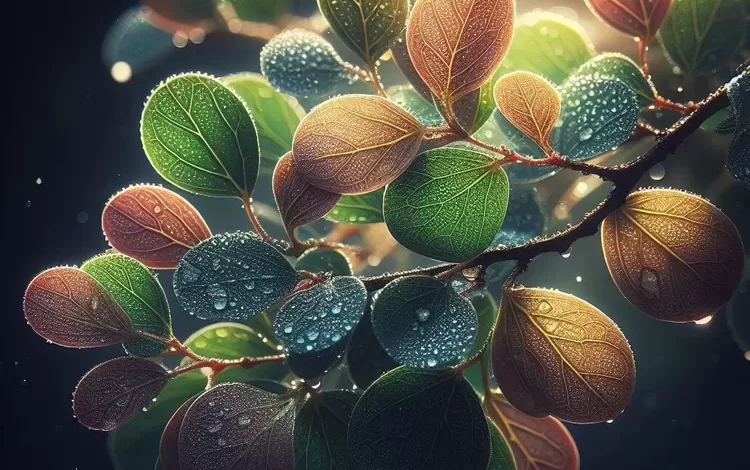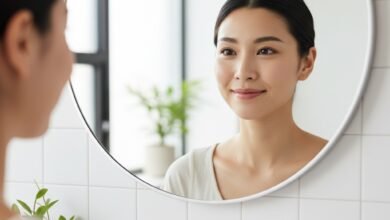How to Make Bidara Leaf Mask for Glowing & Acne-Free Face (DIY Tutorial)

Have you ever felt tired of skincare products full of chemicals that don’t deliver the promised results? Sometimes, the best solutions come from nature, hidden in traditional wisdom that has stood the test of time. One such secret is the Arabian Bidara leaf (Ziziphus spina-christi), a plant known not only in medicine but also as a reliable ingredient for skin beauty.
At Salwa Salon, we believe that true beauty begins with pure and natural ingredients. In this practical tutorial, we will guide you step-by-step to make a Bidara leaf face mask right in your home. Ready to achieve healthier, brighter, and problem-free skin? Let’s begin!
The Amazing Benefits of Bidara Leaves for Facial Beauty
Before we dive into how to make it, it’s important to understand why Bidara leaves are so special for your facial skin. This isn’t just a myth; it’s supported by the active compounds within them.
- Soothes Acne and Redness
Bidara leaves possess powerful anti-inflammatory and antibacterial properties. This makes them a potent weapon against acne-causing bacteria (P. acnes), calming inflammation, and reducing redness on irritated skin. Regular use can help keep skin clean and free from troublesome breakouts. - Fights Premature Aging (Anti-Aging)
Rich in antioxidant compounds like flavonoids, Bidara leaves effectively combat free radicals, which are the main cause of premature aging, such as fine lines and wrinkles. These antioxidants help protect skin cells from damage, maintain elasticity, and make the face appear more youthful. - Deep Cleanses the Face
Bidara leaves contain saponins, compounds that can produce a gentle lather much like natural soap. Saponins help lift dirt, excess oil, and dead skin cells from pores without stripping the skin’s natural moisture. As a result, the skin feels incredibly clean, fresh, and not dry.
Step-by-Step Tutorial: Making a Bidara Leaf Face Mask
Now it’s time to get practical! Follow these easy steps to make your first Bidara leaf mask. This basic recipe is very effective, but we’ll also provide customization tips in the next section.
Step 1: Prepare Ingredients & Tools
The key to a successful DIY recipe is preparation. Make sure you have everything you need before you start. You will need:
Ingredients:
- A handful of fresh Bidara leaves (about 15-20 leaves), or 1 tablespoon of dried Bidara leaf powder.
- Rose water or mineral water as needed.
- 1 teaspoon of pure honey (optional, for extra moisture).
Tools:
- A clean small bowl.
- Mortar and pestle (for fresh leaves) or spoon (for powder).
- Blender (alternative for grinding fresh leaves).
- Mask brush or clean fingers.
Step 2: Clean and Grind Bidara Leaves
If you are using fresh leaves, wash each leaf thoroughly under running water to remove dust and dirt. Gently dry with a clean towel. Next, grind the leaves. You can choose one of these two methods:
- Traditional Method: Use a mortar and pestle to pound the Bidara leaves until they are completely smooth and release their greenish juice. This method is believed to preserve the leaves’ nutrients maximally.
- Modern Method: Put the Bidara leaves into a blender, add one tablespoon of water, then blend until it becomes a smooth paste.
If you are using dried Bidara leaf powder, you can proceed directly to the next step.
Step 3: Mix Ingredients into a Paste
Pour the Bidara leaf paste (or powder) into a clean small bowl. Add pure honey (if using). After that, gradually pour in rose water or mineral water while continuously stirring. Stop adding water when the mixture reaches a thick, spreadable paste consistency, not too runny or too thick.
Step 4: Apply to Face
Ensure your face is clean and dry. Use a mask brush or your fingertips to apply the mask evenly over your entire face. Avoid sensitive areas like the eyes and lips. Gently massage in circular motions while applying to help exfoliate dead skin cells.
Step 5: Let Sit and Rinse Thoroughly
Let the mask dry on your face for about 10-15 minutes. You might feel a slight tightening sensation as the mask dries—this is normal. Afterward, rinse your face with warm water until all mask residue is gone. Gently pat your face dry with a soft towel.
Pro Tips for Maximum Results (Customization According to Skin Type)
Every skin is unique. To get the best benefits, you can adjust the basic recipe above according to your specific skin needs.
For Oily & Acne-Prone Skin
Add 2-3 drops of lemon juice or tea tree oil to your mask mixture. Lemon acts as a natural astringent to help control oil, while tea tree oil will strengthen the antibacterial effect to combat acne.
For Dry & Dull Skin
Replace rose water with plain yogurt or add half a teaspoon of extra virgin olive oil. Yogurt contains lactic acid which moisturizes and brightens the skin, while olive oil provides deep nourishment and hydration.
Important: Perform a Patch Test!
Even though it’s natural, some people may have sensitivity to certain ingredients. Before applying the mask to your entire face, apply a small amount of the mixture to the area behind your ear or on your jawline. Leave it on for 10 minutes. If there is no redness or itching, the mask is safe for you to use.
Find this recipe helpful? This is just the beginning of the world of natural beauty. Imagine if you had dozens of other tested recipes for every skin concern. Get access to our “Exclusive Ebook: 25 Salon-Trusted Natural Mask Recipes” to unlock all the secrets to healthy and glowing skin!
Making a Bidara leaf mask at home is not only easy and cost-effective but also an excellent way to provide pure nourishment to your skin. With its anti-acne, anti-aging, and deep-cleansing benefits, Bidara leaves deserve a place in your weekly skincare routine. Try this tutorial, customize it for your skin type, and experience the magic of this natural ingredient for healthier, more radiant skin.






